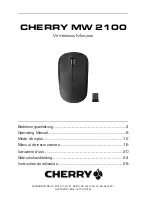
7
USB Interface
All USB Human Interface
Device (HID) class applications
follow the same USB start-up
procedure. The procedure is as
follows
1. Device Plug-in
When a USB device is first
connected to the bus, it is
powered and running
firmware, but
communications on the USB
remain non-functional until
the host has issued a USB
bus reset.
2. Bus Reset
The pull-up resistor on D–
notifies the hub that a low
speed (1.5 Mbps) device has
just been connected. The
host recognizes the presence
of a new USB device and
initiates a bus reset to that
device.
3. Enumeration
The host initiates SETUP
transactions that reveal
general and device specific
information about the mouse.
When the description is
received, the host assigns a
new and unique USB
address to the mouse. The
mouse begins responding to
communication with the
newly assigned address,
while the host continues to
ask for information about the
device description,
configuration description and
HID report description. Using
the information returned
from the mouse, the host
now knows the number of
data endpoints supported by
the mouse (2). At this point,
the process of enumeration
is completed.
Notes:
1. idVendor should be changed to the value as
supplied by the USB-IF
2. idProduct should be assigned for specific
product.
3. MaxPower value should be changed as per
specific circuit’s current draw.
4. Post Enumeration Operation
Once communication between
the host and mouse is
established, the peripheral
now has the task of sending
and receiving data on the
control and data endpoints.
In this case, when the host
configures endpoint 1, the
mouse starts to transmit
button and motion data back
to the host when there is
data to send. At any time
the peripheral may be reset
or reconfigured by the host.
USB Requests – Endpoint 0
Endpoint 0 acts as the control
endpoint for the host. On
power-up endpoint 0 is the
default communication channel
for all USB devices. The host
initiates Control- Read and
Control-Write (see Chapter 8 of
the USB specification) to
determine the device type and
how to configure
communications with the
device. In this particular
design, only Control-Read
transactions are required to
enumerate a mouse. For a list
of valid requests see Chapter 9
of the USBG specification. In
addition to the standard
“Chapter 9” requests, a mouse
must also support all valid HID
class requests for a mouse.
USB Requests – Endpoint 1
Endpoint 1 is the data transfer
communications channel for
mouse button, wheel, and
movement information.
Requests to this endpoint are
not recognized until the host
configures endpoint 1. Once
this endpoint is enabled, then
interrupt IN requests are sent
from the host to the mouse to
gather mouse data. When the
mouse is left idle (i.e. no
movement, no new button
presses, no wheel movement)
the firmware will NAK requests
to this endpoint. Data is only
reported when there is a status
change with the mouse.
Two HID report formats are
used in this design. The boot
protocol, as defined by the HID
specification, is the default
report protocol that all USB
enabled systems understands.
The boot protocol has a three-
byte format, and so does not
report wheel information. The
HID report descriptor defines
the report protocol format. This
format is four bytes and is the
same as the report format with
the exception of the fourth
byte, which is the wheel
information. Appendix F of this
document lists the USB Data
Reporting Format.
PS/2 Interface
The host driver determines the
PS/2 mouse start up sequence.
However, a few standard
commands must be sent in
order to enable all PS/2 mice.
The mouse is the clock master
on this bus. The host must
request the mouse to clock
data into itself.
1. Device Plug-in
When a PS/2 mouse is first
connected to the bus, it is
powered and is running
firmware. PS/2
communications generally
begin with the host sending
a RESET command to the
mouse. The mouse will not
report button, wheel, or
movement back to the host
until the ENABLE command
is sent. Depending on the
particular operating system
the mouse is used with, the
start up sequence will vary.
Содержание ADNK-6003
Страница 17: ...17 Figure C2 PCB Schematic Top Layer Figure C1 PCB Schematic Bottom Layer Appendix C PCB Layout...
Страница 18: ...18 Figure C4 PCB Schematic Bottom Overlay Figure C3 PCB Schematic Top Overlay...
Страница 19: ...19 Appendix D Base Plate Feature Figure D1 Overall view of base plate...








































